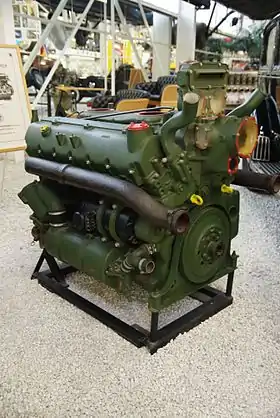Maybach HL230
The Maybach HL230 was a water-cooled 60° 23 litre V12 petrol engine designed by Maybach. It was used during World War II in heavy German tanks, namely the Panther, Jagdpanther, Tiger II, Jagdtiger (HL230 P30), and later versions of the Tiger I and Sturmtiger (HL230 P45).
| Maybach HL230 | |
|---|---|
 The Maybach HL230 in Sinsheim Auto & Technik Museum | |
| Overview | |
| Manufacturer | Maybach |
| Layout | |
| Configuration | V-12 |
| Displacement | 23.095 L (1,409.3 cu in) |
| Cylinder bore | 130 mm (5.1 in) |
| Piston stroke | 145 mm (5.7 in) |
| Cylinder block material | Cast-aluminium |
| Cylinder head material | Cast-iron |
| Valvetrain | SOHC |
| Compression ratio | 6.8:1 |
| Output | |
| Power output | 700 PS (510 kW; 690 hp) @ 3,000 rpm |
| Dimensions | |
| Dry weight | 1,200 kg (2,600 lb) |
Description
The engine was an upgraded version of the slightly smaller HL210 engine which was used to equip the first 250 Tiger I tanks built, and which had an aluminium crankcase and block. The earlier HL210 engine had a displacement of 21.353 L (1,303.0 cu in) or 1,779 cm³ per cylinder; bore 125 mm (4.9 in), stroke 145 mm (5.7 in).
With the HL230, engine bore was increased from 125 mm to 130 mm. It had a displacement of 23.095 L (1,409.3 cu in) or 1.925 cm³ per cylinder; bore 130 mm (5.1 in), stroke 145 mm (5.7 in). The maximum output of 700 PS (690 hp, 515 kW) at 3,000 rpm. Maximum torque is 1850 Nm (1364.5 ft lbs) at 2,100 rpm. Typical output was 600 PS (592 hp, 441 kW) at 2,500 rpm.
The crankcase and block of the HL230 were made of grey cast iron and the cylinder heads from cast iron. The engine weighed 1200 kg and its dimensions were 1,000 mm × 1,190 mm × 1,310 mm (3 ft 3 in × 3 ft 11 in × 4 ft 4 in). Aspiration was provided by four twin-choke Solex type 52JFF carburettors. Ignition was by two magnetos. The compression ratio was 6.8:1. As was typical practice for Maybach, the engine used a tunnel crankshaft.
Late in the war the HL234 upgrade with fuel injection was recommended by the Entwicklungskommission Panzer for use in the underpowered Tiger II tank. The power output was expected to increase to between 800 and 900 PS (hp), and with supercharging to 1100 to 1200 hp. [1]
Production
Approximately 9,000 HL230s were produced in total by Maybach, Auto Union and Daimler-Benz.
Beginning on 3 November 1944, they were produced at the Richard I underground factory at Leitmeritz concentration camp.[2]
See also
- List of WWII Maybach engines
- Kharkiv model V-2, equivalent contemporary Soviet tank engine
- Rolls-Royce Meteor, equivalent contemporary British tank engine
References
- German Tanks of World War II. F M von Senger und Etterlin: Arms and Armour Press, 1969, 1973 ISBN
- Skriebeleit, Jörg (2007). "Leitmeritz". In Benz, Wolfgang; Distel, Barbara (eds.). Flossenbürg: das Konzentrationslager Flossenbürg und seine Außenlager [Flossenbürg: Flossenbürg Concentration Camp and its Subcamps] (in German). Munich: C. H. Beck. p. 171. ISBN 9783406562297.
External links
- Copy of British report on the HL230 and HL210 engines - Tiger I Information Center
- Detailed picture gallery of HL230 Tiger engine overhaul - Armytech.com
- French Army studies of captured equipment, 1945. "General Arrangement drawings, HL230 P30". Servicehistorique.sga.defense.gouv.fr. Archived from the original (TIFF) on 2007-12-16.